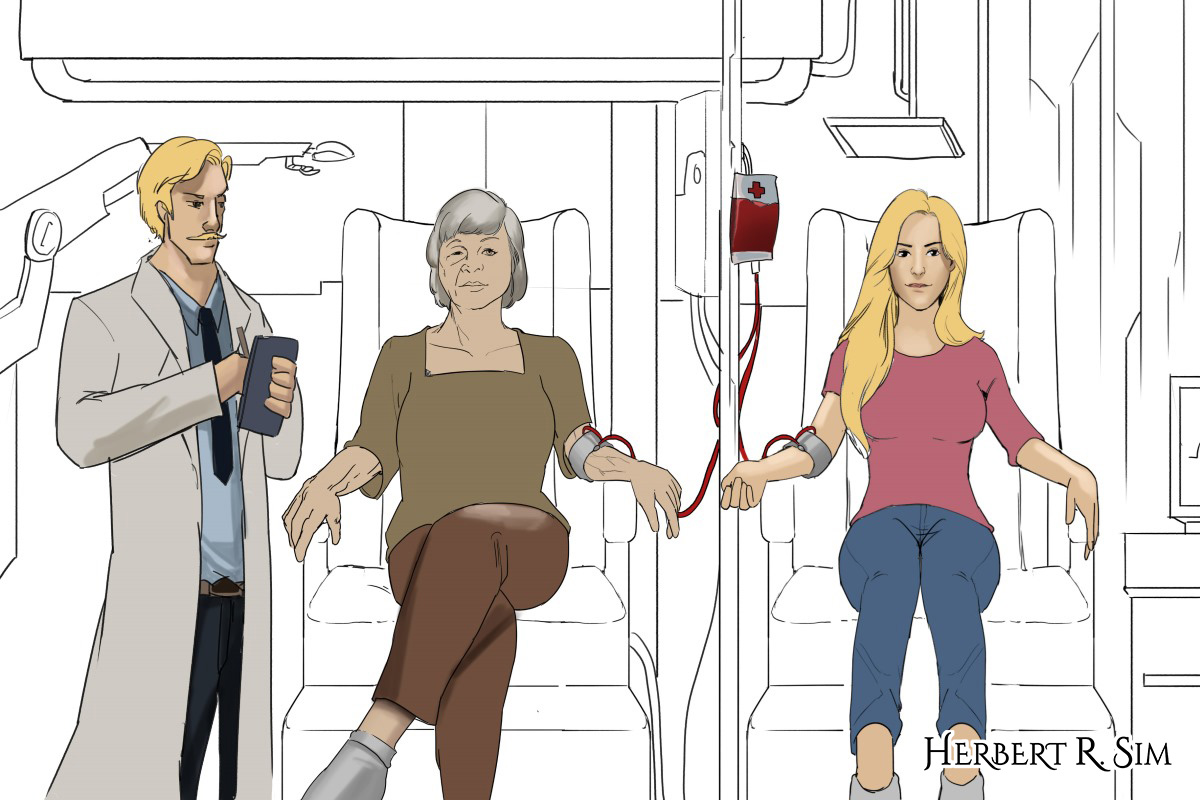
In my sketch, I illustrate a younger woman, doing a live transfusion of her blood, to the older woman.
——————————————————-
Throughout history, the quest to reverse the ageing process has often intrigued mankind. From mythical tales of the Fountain of Youth to the ancient practices of alchemy, people have long searched for ways to prolong not just their lives, but to be able to live it without experiencing the side effects of ageing.
The modern day pursuit has persisted, with scientists and researchers conducting various experiments and studies in a bid to satisfy mankind’s thirst for quality longevity. Naturally, the transfusion of blood from young individuals to older recipients has risen to the fore, a plausible solution that could well evolve into a mainstream method.
The concept of blood transfusions as a means to rejuvenate the body can be traced back to the 1950s, when Dr. Clive McCay, a biochemist from Cornell University, conducted experiments on parabiotic rodents. By connecting the circulatory systems of young and old mice, McCay observed that the older mice exhibited signs of improved health and vitality.
Fast forward to the early 21st century and researchers have begun to unravel the mystery behind these observations. Studies have shown that certain proteins found in the blood of young individuals, such as GDF11 (Growth Differentiation Factor 11), have the potential to reverse age-related degeneration in organs and tissues. GDF11, in particular, has demonstrated the ability to rejuvenate the heart, brain, and skeletal muscle in older mice, leading to improved physical and cognitive function.
In fact, researchers at the Harvard Stem Cell Institute conducted a study in 2013 that demonstrated the potential of the protein GDF11 to reverse age-related decline in mice. The study involved injecting GDF11 into older mice and monitoring the effects on their skeletal muscle, heart, and brain. According to the study, GDF11 improved the mice’s physical and mental abilities and even sped up the development of new brain blood vessels and neurons. It also provided valuable insights into how young blood might promote rejuvenation in older individuals.
A relentless quest
Studies involving anti-ageing blood transfusions have spanned multiple universities and research firms, highlighting the growing interest in the topic and perhaps, land crucial steps towards bringing the therapies closer to clinical application.
In 2013, a study led by researchers at the University of California, Berkeley, found that when old mice were injected with blood from young mice, their cognitive abilities improved. The study focused on a specific protein called CCL11, which is found at higher levels in the blood of older mice. When CCL11 was injected into young mice, their cognitive function suffered, indicating that this protein may contribute to age-related cognitive decline. As a result, this study added to the growing body of evidence which suggested that elements in youthful blood may help improve the cognitive function of elderly people.
The effects of young blood transfusions on elderly mice were the subject of a ground-breaking study carried out by a team of Stanford University scientists in 2014. The study discovered that synaptic plasticity, learning, and memory were all significantly enhanced in older mice that received plasma from youthful donors. These results imply that elements in young people’s blood may have a rejuvenating effect on the ageing brain.
In the same year, Northern California startup Alkahest also financed a Stanford research trial that received FDA approval to administer four modest, weekly plasma infusions to Alzheimer’s patients, between the ages of 50 and 90. The Stanford Blood Center, which has a separate research arm that only takes blood donations for Stanford clinical trials, is where the plasma is collected. In order to monitor any potential changes in disease symptoms, the patients are also given blood tests, brain scans, and memory evaluations. The company’s long-term objective is to identify the blood proteins that alter with ageing and then synthesize these elements into pharmaceutical drugs.
In 2016, a start-up called Ambrosia Health launched a clinical trial to test the effects of young blood transfusions on human participants. The trial involved over 100 participants, aged 35 to 92, who received plasma infusions from donors aged 16 to 25. The trial aimed to assess the potential benefits of young plasma infusions on biomarkers of ageing, such as inflammation, muscle mass, and cognitive function. Although the company ceased operations in 2019, the trial marked one of the first attempts to explore the potential benefits of young blood transfusions in humans.
——————————————————-

In the detailing and coloring process of the art illustration, you can clearly see that half of the older woman’s face, her skin has started to rejuvenate, looking younger, wrinkle-free!
——————————————————-
A treatment that holds so much promise
The volume of research and intensity, arguably, would reflect the firm belief that anti-ageing blood transfusions are genuine and potentially effective. Proponents would also argue that such research do not necessarily contribute to rebelling against nature, but rather, to improve the overall quality of life and alleviate effects of age-related diseases.
Although human trials are still in its infancy, the potential of anti-ageing blood transfusions is immense, capable of tackling and treating a wide range of age-related illnesses. Essentially, the regeneration abilities of young blood might help to reduce the severity of conditions such as heart disease, stroke, arthritis, and possibly some forms of cancer. Other potential benefits include:
Immune system rejuvenation: Research suggests that young blood transfusions might help strengthen the immune system in older individuals. As we age, our immune system’s ability to effectively respond to infections and diseases declines. By introducing factors present in young blood, it may be possible to enhance the older recipient’s immune response and overall resistance to illness.
Reduction in age-related inflammation: Chronic inflammation is linked to a number of age-related disorders and can have a negative impact on our general health as we become older. Transfusions of young blood may assist elderly people experience less inflammation, which may lessen their chance of contracting inflammatory disorders and enhance their general health.
Enhanced vitality: As we age, our energy levels and stamina often decline. The rejuvenating factors found in young blood could potentially help restore energy levels and vitality in older individuals, allowing them to maintain a more active lifestyle and better enjoy their golden years.
Improved cognitive function: Studies have shown that blood transfusions from young donors can enhance learning, memory, and synaptic plasticity in older recipients. This could potentially provide relief for those suffering from neurodegenerative diseases such as Alzheimer’s and Parkinson’s.
Revitalisation of organs and tissues: Research has demonstrated that certain proteins in young blood can reverse age-related degeneration in the heart, brain, and skeletal muscle, leading to improved physical function and vitality.
Enhanced wound healing and tissue repair: Blood transfusions from young donors may promote the healing of wounds and the regeneration of damaged tissues in older individuals, reducing recovery times and improving overall health.
Bone health support: Osteoporosis, a disorder that raises the risk of fractures and accidents, can result from age-related bone loss. Transfusions of anti-ageing blood may help older people have stronger, denser bones, which lowers their risk of fractures and improves general bone health.
——————————————————-

In my final illustration, it was about detailing final touches in the shadings, and featuring the words – Longevity Science, Blood Upgrade and Blood Enhancement – of which I believe that it will be a big trend in the near future.
——————————————————-
From the ethicist’s perspective
While the potential benefits of performing anti-ageing blood have turned the heads of the scientific community as well as caught the attention of the wider public, hesitation and ethical questions are bound to surface. In particular, critics argue that the harvesting of blood from young individuals – for the purpose of rejuvenating older recipients – could lead to the exploitation and commodification of the young.
However, as with most scientific dilemmas and studies that aim to offer solutions involving the human body, it is crucial that researchers and policymakers work together to address the ethical concerns and establish guidelines. Specifically, a well-balanced one that could ensure that the potential benefits of anti-ageing blood transfusions are realised in a responsible manner.
Additionally, the potential impact of anti-ageing blood transfusions on society must be considered. There will be effects on healthcare systems, retirement ages, and the social and economic institutions that support an ageing population as a result of the possibility of enhanced longevity and improved health. To better prepare for a future where the definition of old age could be redefined, it is critical to participate in a wider discussion about the implications of prolonging human life as we work towards the development of effective anti-ageing processes.
Again, it is imperative that vigilance is key for anti-ageing blood transfusions to work, to not stray and provoke those who question, but rather, with the single-minded focus to normalise the tapping of young blood – harnessed for the betterment of humankind.
https://pafipemkokalimantan.org/
https://pafikabupatenpandeglang.org/
https://pafikabupatenprobolinggo.org/
https://pafikabupatenpamekasan.org/
https://idikotapontianak.org/
